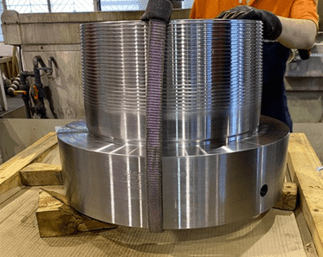Vallourec has recently produced 2 lifting plugs using Wire Arc Additive Manufacturing (WAAM) meeting Weatherford’s urgent operational demands.
Lifting plugs are crucial safety components that serve as the interface between the rig elevator and the pipes. They are utilised on the rig’s surface to enable operators to safely handle and transport long tubular items.
Historically, lifting plugs have been manufactured from forged thick-wall bars. Due to the fact that they are a safety-critical component utilised on the surface, they require non-standard material with specific mechanical qualities, resulting in extended lead times. Due to the fact that lifting plugs connect to existing equipment, specific dimensions are occasionally required to assure compatibility across all components, further extending lead times. Additionally, maintaining inventories of raw materials in non-standard sizes is inefficient and may result in waste if they are never used. All of this results in the inability to meet critical deadlines.
When Weatherford approached Vallourec with an urgent need for a VAM® TTR HW Riser Lifting Plug capable of 100T for a customer’s workover scope off the coast of Australia, Vallourec suggested a more cost-effective and quicker solution based on additive manufacturing (AM).
The lifting plugs were redesigned in collaboration with WAAM to accommodate custom non-standard diameters compatible with Weatherford’s current equipment. As a result, the outer diameter (OD) of the lifting plugs was raised by 15% at the customer’s request. Vallourec was able to reduce any weight gain by re-designing the component without impairing lifting performance by leveraging WAAM’s flexibility.
These new lifting plugs were 3D-printed using the Vallourec WAAM robot in Singapore, which is only a 6-hour flight from the end-customer. The safety-critical components were supplied in less than two months, rather than the customary three to four months.
Changing the industry
Wire Arc Additive Manufacturing (WAAM) is an additive manufacturing (AM) process that employs a welding source and a robot arm to drive a printing nozzle to deposit material in near-net forms layer by layer. After depositing all of the material, the blank is machined, tested, and VAM® threaded.
Welding is a critical component of industrial component production processes and a subject in which Vallourec is renowned as a specialist.
Vallourec’s first 3D-printed safety-critical component was a waterbushing developed in partnership with TotalEnergies and placed in the North Sea’s EIG Franklin well in early 2021. This successful project paved the way for other opportunities, including this newest one with Weatherford.
WAAM – and AM more broadly – provides various benefits to the oil and gas sector, the most significant of which being reduced, assured lead times, which would benefit end users significantly.
Additionally, WAAM enables greater form flexibility – parts may be manufactured to the precise size and requirements specified by the client – as well as printing of extremely big components. The end result of this procedure is that businesses may construct a digital or virtual warehouse from which they can order spare components in the form of a printed file.


